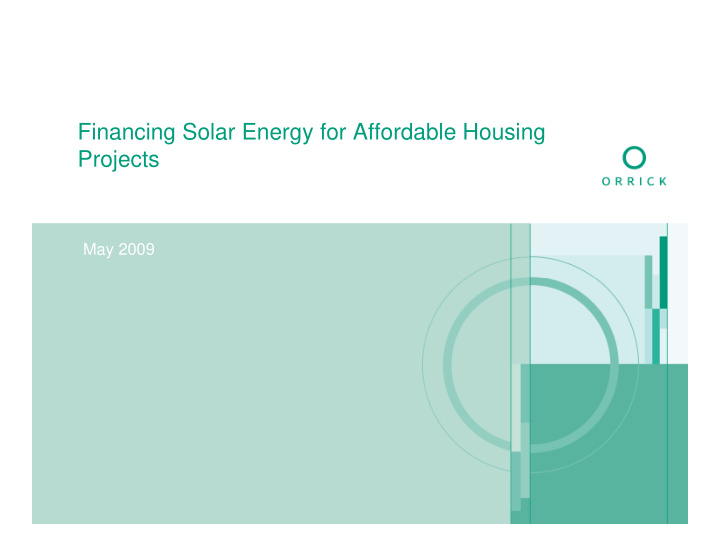



Financing Solar Energy for Affordable Housing Projects May 2009
Overview • Photovoltaic Systems . Installations of photovoltaic systems on the customer side (as opposed to the utility side) of the meter have increased at an annual growth rate of more than 50% in recent years. • Financing Structures . Different financing structures and participant roles have developed for PV installations, including balance sheet financing, leases, and power purchase agreements (PPAs). • Integration with Affordable Housing . Affordable housing developments may make use of lease financing or the PPA model to acquire, install and benefit from PV systems. � Lock in energy costs at competitive rates � Potential to earn developer fee as PPA Provider • Stimulus Bill . The American Recovery and Reinvestment Act created a variety of tax-exempt and tax credit bond financing techniques that may be used for solar energy. 2
Financing Structures I • Balance Sheet Financing. Host finances acquisition and installation of a PV system using its own equity and/or debt carried on its balance sheet. � High up-front cost � Steep learning curve for Host � Generally inapplicable in the affordable housing context • Operating or Capital Lease. Host (lessee) rents a PV system under an operating lease or capital lease; host maintains the system. � Low up-front cost � Lessee retains maintenance responsibilities � Lessor arranges financing, takes tax benefits (operating leases only) � Lease payments determined based on lease term and residual value 3
Financing Structures II • Power Purchase Agreement (PPA). Host enters into a long-term power purchase agreement with a PPA Provider (project developer) that arranges financing through a partnership structure. � Site Lease from Host to PPA Provider. � PPA between project company and Host establishes fixed rate per kWhr for all electricity produced by the system. Typical term is 20 years. � Non-recourse, stand-alone project financing, similar to multifamily rental housing. � Single-purpose project company or partnership created by the PPA Provider as developer and sponsor. � PPA Provider arranges financing, acquires, installs and maintains the PV system. � Key project elements include site control, insurance, casualty and condemnation, host credit quality, construction, debt, tax incentives and other subsidies, and equity. 4
Lease Structure Cash Equity or Sponsor Tax Equity Investor Lease Loan Agreement Lessee Lender Lessor Lessee Lender Operations & Project Maintenance Assets Site 5
PPA Structure Cash Equity or Sponsor Tax Equity Investor Power Purchase Agreement (PPA) Loan Agreement SPV Project Host/Customer Lender Host/Customer Company Lender Site Lease Operations & Project Maintenance Assets Site 6
Tax Equity Funding and other Subsidies • Energy Tax Credit Market � 2005 Energy Policy Act increased the Investment Tax Credit (ITC) from 10% to 30% of qualified project cost. � Institutional tax equity market has deteriorated, with a limited number of players still active. New sources of tax equity are being sought. � Stimulus Bill generally allows projects that could claim the ITC to obtain a cash grant from the U.S. Treasury instead. � ITC grant does not provide monetization of the significant tax benefits arising from accelerated depreciation, which favors bringing in tax equity investors at least on larger, and leveraged, projects. • State Subsidies � California Solar Initiative (CSI) provides solar incentives for projects in the territories of PG&E, SoCal Edison, and SDG&E. Other states have similar programs, as do some CA municipal utility districts. � CSI can provide 25% or more of the cost of a project, although the subsidy is declining over time. � Renewable Energy Certificates (RECs) may provide additional value. 7
Integration with Affordable Housing • Lease or PPA Structure Possible � PPA offers turnkey solution with no ongoing maintenance obligation � Lease is generally more economical for smaller installations ‒ Typical single-family residential rooftop system is 10-12 kW ‒ 1 MW system installed costs roughly $6-8 million ‒ PPA transaction costs are typically $500k plus • Owner may engage PPA Provider or act as PPA Provider/developer of the PV system � Separate PV project company/partnership with own capital structure � Net metering allows sale of excess output � PPA Provider earns residual cash flow or developer fee • Credit issues � Lender underwriting based on Project’s credit as lessee or offtaker � Third-party credit enhancement may be needed 8
Stimulus Bill – New Bonds and Programs • Qualified Energy Conservation Bonds � QECBs are tax credit bonds that can used to finance a broad array of “green” expenditures including renewable energy facilities. QECBs can also finance costs of issuing the bonds, obtaining credit enhancement and debt service reserves, if required. � Total national allocation is $3.2 billion, of which up to 30% may be used for private activity bonds. IRS Notice 2009-29 allocated $381,329,000 to California. • Recovery Zone Facility Bonds � RZFBs are private activity bonds that may be used to finance the original use of almost any depreciable property within a “recovery zone”, defined as a qualifying city or county designated by the bond issuer as having significant poverty, unemployment, rate of home foreclosures, or general distress. � Total national allocation is $15 billion. IRS will allocate to states based on relative declines in employment in 2008, and states will reallocate among counties and municipalities with 100,000+ population in proportion to relative 2008 job loss. • DOE Loan Guarantees � Stimulus Bill extended existing Department of Energy Loan Guarantee program � First loan guarantee conditionally approved (for Solyndra, a solar panel manufacturer) under the old DOE loan program after 3 years of effort and millions of dollars in expenses � New (and improved?) program rules have not yet been issued 9
Recommend
More recommend